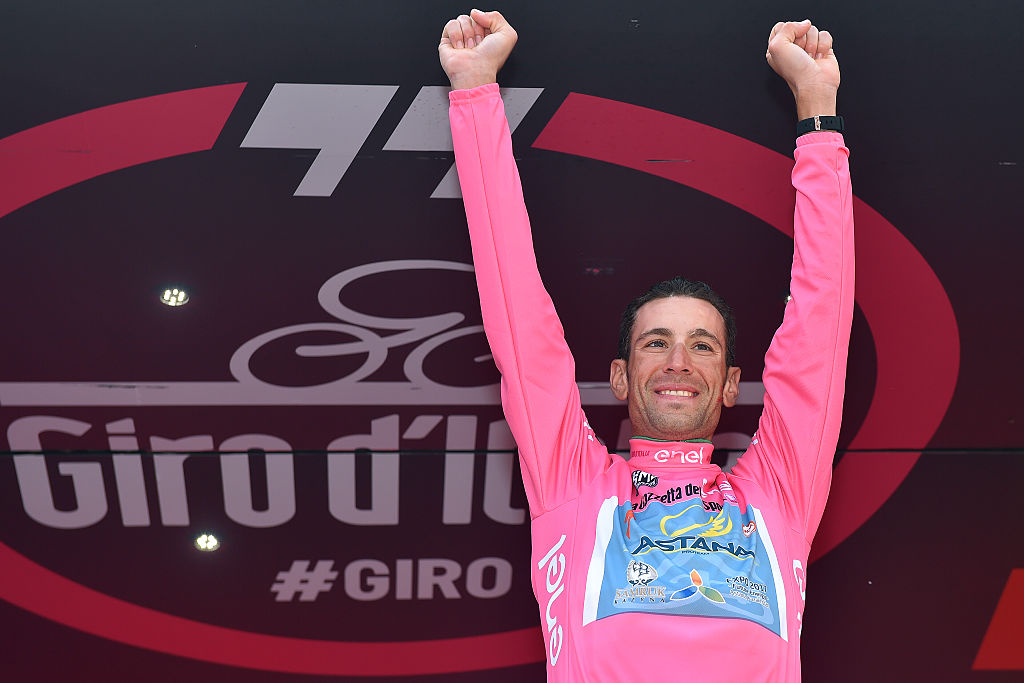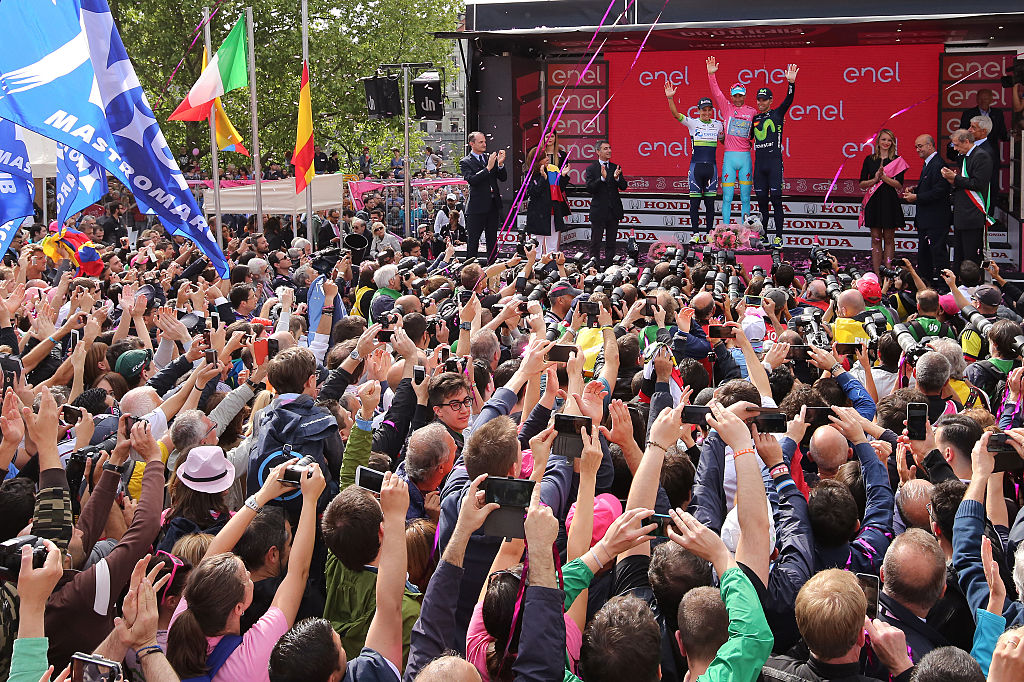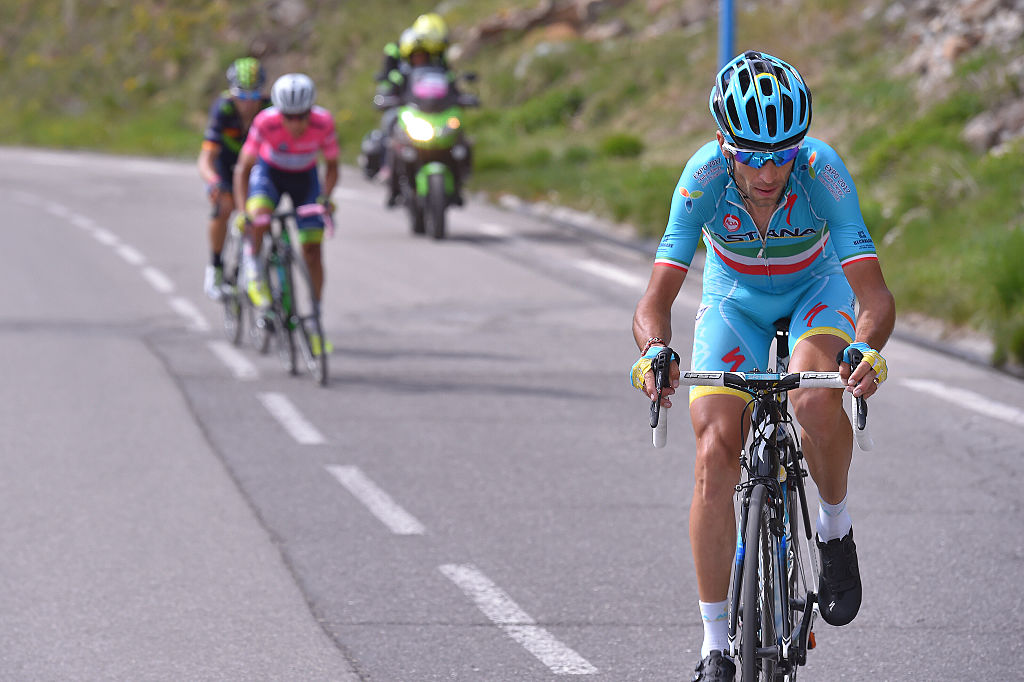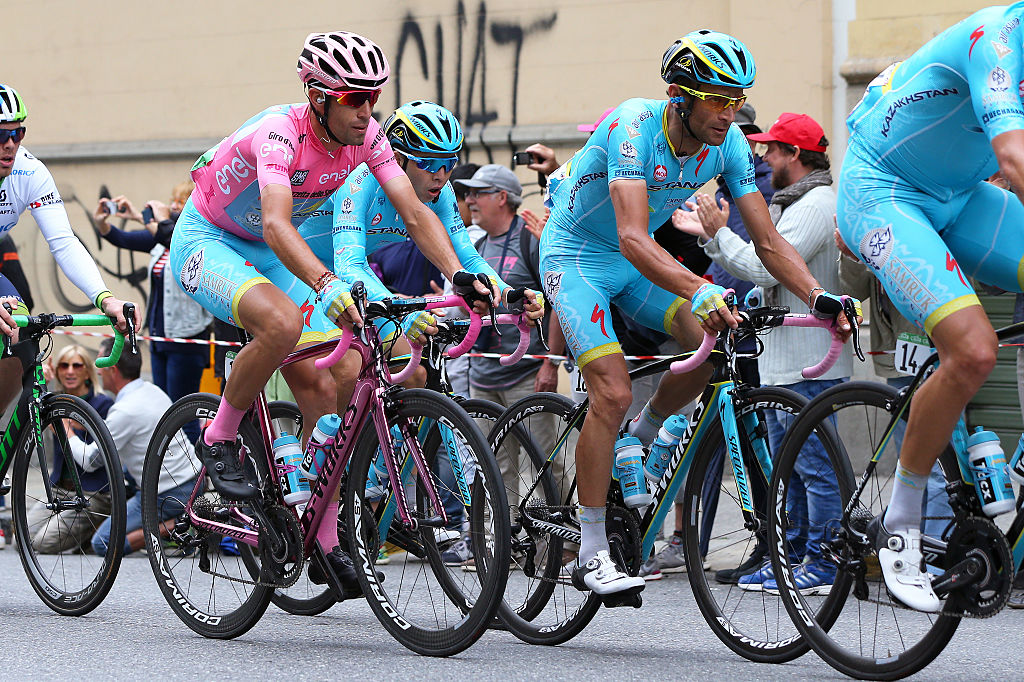Big fish, small pond: Vincenzo Nibali and the 2016 Giro d'Italia
Looking back at the Sicilian's rollercoaster victory




Procycling magazine: the best writing and photography from inside the world's toughest sport. Pick up your copy now in all good newsagents and supermarkets, or get a Procycling print or digital subscription, and never miss an issue.
On Thursday, the Giro d'Italia was due to continue in Sicily on stage 5, with a 138km route from Catania to Villafranca. With the COVID-19 pandemic leaving us without a Giro, for the time being at least, today we feature Sicily native Vincenzo Nibali, revisiting his 2016 Giro win via this article from Procycling, originally published in August 2016.
One hundred and sixty-nine years after the Italian national anthem was born in Turin, an impromptu rendition of Fratelli d'Italia (Brothers of Italy) broke out in a crowd of people, on a street in the same city, on a Sunday afternoon in May 2016.
Oddly, the crowd of singers were gathered around the huge flag of another nation – Kazakhstan. Vincenzo Nibali, the winner of the 99th edition of the Giro d'Italia, had just tripped down the steps of his Astana team bus, onto the tarmac, and beamed at the four-deep throng. It was then that the words and the music came: "Fratelli d'Italia, l'Italia s'è desta…"
A day earlier, Nibali had soared into the lead and an unassailable position for the first time since the Giro had left the Netherlands three weeks earlier. Two days before that, he had looked dead and buried, a pre-race favourite and home hero sagging under the weight of his reputation and past achievements. Among assorted other complaints and attempts to explain – to himself as much as to his fans – Nibali had used words not previously in his lexicon: "pressure", "expectation", "stress".
His coach, Paolo Slongo, grumbled that Nibali was finally showing a sensitivity thus far only known to his innermost entourage.
"If he hears a million nice things but one person in the crowd shouts something negative, that's what he remembers and obsesses over," Slongo said.
Get The Leadout Newsletter
The latest race content, interviews, features, reviews and expert buying guides, direct to your inbox!
It had been a different story when Nibali won his last Grand Tour: the 2014 Tour de France. There, he encountered, and seemed to shrug off, a different kind of mental strain. By far the strongest rider in a modest field weakened by the early withdrawals of Chris Froome and Alberto Contador and the absence of Nairo Quintana, the Italian's superiority led to persistent questions about his credibility, those of his Kazakh team, and the Tour's sordid not-too-distant history. On no occasion then did Nibali look as flustered as in this Giro, either on or off the bike.
In Pinerolo, after stage 18, Nibali lay fourth on general classification, four minutes and 43 seconds behind the increasingly assured race leader, Steven Kruijswijk. Nibali would win the first of two mammoth Alpine stages to Risoul the following day, before overhauling the next man on his chopping block, Esteban Chaves, at Sant'Anna di Vinadio. Then in Turin he could finally smile, sing along with his "Brothers of Italy", and brace himself for questions about exactly how he had turned around a Giro that for almost three weeks had seemed to be heading for disaster.
Winning hearts and minds
Perhaps the most damning of all murmurs around Nibali are those suggesting a connection with the disgraced sports doctor, Michele Ferrari. These swirled once again at the end of the Giro, while appearing to still hang on scarce evidence. The rumours arose first when the Amore e Vita team owner and self-proclaimed anti-doping crusader Ivano Fanini claimed he'd seen Nibali training behind Ferrari's moped near St Moritz in 2009. Fanini later retracted the allegations when Nibali issued a strong denial and the threat of legal action.
The whispers returned, and were again quashed, when Nibali dominated the Tour in 2014. Not long after that, journalists obtained copies of the 550-page dossier compiled by a Padova magistrate who had investigated Ferrari over several years up to 2012. Several of Nibali's teammates during his time at Liquigas were named in the files, as was the Astana team manager Alexandre Vinokourov, but Nibali was not. Slongo, Nibali's coach, is vaguely name-checked on page 19 of the 550-page document as having had contact with Ferrari, but the link is never explained or repeated. Slongo brought legal action against two journalists from La Repubblicawho, based on the dossier, reported that Slongo was "regularly in touch" with Ferrari.
Ferrari also mocked the claims, writing on his 53x12 blog that he and Slongo had indeed often met face to face at the hotel Parador del Teide where Ferrari's clients, plus dozens of other riders including Nibali, went to train at altitude – "every morning, in front of the buffet breakfast, with the topic: 'Is it better to have eggs with bacon or muesli with yoghurt?'"
After this year's Giro, Ferrari used the same platform to muse that Nibali's switch to longer cranks at the start of the season – and the decision to revert back two days from the end of the Giro, on the advice of his father – might explain the bust-to-boom of his three weeks in Italy. And, as ever with Ferrari, the curious and conspiratorial were lining up to decipher the subliminal messages, the double and triple-bluffs in his analysis of a race whose "technical level", according to the doctor, was "not very high".
The number-crunchers were largely in agreement: the Giro gave us silver rather than gold-standard performances, as the starting field suggested it would. Privately, Team Sky believed that Mikel Landa would have equalled if not comfortably beaten Nibali had illness not ended his race in Tuscany. Steven Kruijswijk claimed that his wattages were no higher than in 2015, which implied that the opposition had been considerably worse (he'd been one of the four or five best climbers in most of the mountain stages in 2015 and finished seventh overall). And, as much as Esteban Chaves enchanted the galleries, it was also tough to argue that his second place represented definitive proof of his arrival among Grand Tour royalty.

What Chaves did certainly win was hearts. He and his Orica-GreenEdge directeur sportif Matt White already form the most engaging soldier-general double act in cycling. Chaves showed here and at last year's Vuelta that it's possible to contend for a major tour while both exuding and experiencing joy. Judged too slight, too fragile by some in his early career, he is now rewarding Orica for the faith, long-term planning and also rehab work after a terrible crash in the 2013 Trofeo Laigueglia they put behind him even before he joined the team for the start of the 2014 season.
In White, the embodiment of off-the-cuff, up-and-at-'em Aussie spirit, Chaves appears to have found the right blend of science, atmosphere and improvisation to thrive. Those who know him also say that behind the ever-ready smile lies a flinty resolve; he may lack the cold-eyed ruthlessness of countryman Nairo Quintana, and perhaps also a smidgen of the Movistar man's once-in-a-generation talent, but Chaves has already demonstrated numerous times during his career that appearances can deceive. No sooner had he raised his arms in jubilation at Corvara than he was criticising the governers of his home city, Bogotá, for not shelling out to host a stage of the Vuelta a Colombia.
Hitting the heights
While Chaves' domestiques, particularly Damian Howson and Rubén Plaza, saved him more than once, Kruijswijk's lack of support from his LottoNL-Jumbo team ended up costing him. He rode aggressively, with verve, at Pinerolo on stage 18. But the need to attack that day came partly from a desire to beckon Nibali and Valverde out of their respective cocoons and into one-on-one combat.
Kruijswijk believed that the guerilla war was one that he could and would win. Alas, when his legs began chopping high on the Colle dell'Agnello shortly before his fateful crash on the descent, one wondered whether Kruijswijk hadn't been trying too hard to scorch the earth. Kruijswijk had paid for his inexperience as much if not more than for his thin team in the mountains.
Of course, as the Italians say, the graveyards are full of hindsight. It just so happened that by tumbling on the Agnello, Kruijswijk had also entombed his chance of winning.
The next afternoon, he crossed the finish line at the sanctuary of Sant' Anna and collapsed to the tarmac, having braved the pain of a broken rib. He had stopped the clock 1:50 from Nibali overall. When he rose to his feet, Kruijswijk didn't reignite fatuous debate about whether the Italian, Chaves or Valverde should have waited after his fall the previous day. Instead he told reporters that "staying on your bike is also part of the race".
In the next, strained breath, Kruijswijk also admitted that, at nearly 29, he may never get a better chance to win a major tour. As scant consolation, over the previous three weeks Kruijswijk had shown immense class both on and off the bike, suggesting that his team may have hitched their Grand Tour horse to the wrong wagons in recent seasons.
The Dutch have not won a major tour since Joop Zoetemelk's 1980 Tour victory, but this one had at least begun with a home triumph. Tom Dumoulin's was the pink cherry on a gloriously iced cake – a Grande Partenza from Apeldoorn so joyous, popular and lucrative that RCS must already know that next year's 100th Giro will begin with a relative anticlimax, most likely in Sardinia.
Just as Dumoulin pulled out, citing a saddle sore (but apparently more concerned with his Olympic preparation, per the peloton grapevine), Vegni's 2016 symphony was thumping into crescendo. A watchable but undramatic first week had ended with a gem of a stage, both visually and tactically, climaxing with the Alpe di Poti gravel-road climb and finale in Arezzo. Week two then served up three of the media montagna stages whose great merits the Grand Tour organisers have finally recognised. Here, too, the action hummed with suspense and tension more than it fizzed with aggression or imagination. This, though, is becoming another major tour trope, both from the viewpoint of the riders and the organisers – a compromise we see in Italy, France and Spain: for a narrative to offer its most gripping twists and turns on or just before the last weekend.
Vegni and Nibali both met their brief but it was a nervous tightrope walk. The Giro had climbed above 2,000m 10 times in a single edition only once before, in 1994. No Tour or Vuelta has ever gone so high, so often.
Repeating that high-wire act this year, with the Giro now a week earlier in the calendar and the spring climate increasingly unpredictable in Italy, seemed an unnecessary gamble and a sure way of tempting fate. Vegni ultimately got away with it.
Nibali will also have thanked the weather gods for sparing him a second diluted Giro win, after his snowbound 2013 victory. Perhaps more to the point, route changes or cancellations this year would have left him stranded, with the rejuvenated legs to topple Kruijswijk but having run out of road. As it turned out, Astana didn't need to do anything particularly novel or clever to pull off what was miscast as a miraculous recovery. The tactic of sending riders up the road to act as disposable sherpas later in a mountain stage is as old as the hills where Nibali forced Kruijswijk into his mistake and Chaves into retreat. But still, Michele Scarponi and Tanel Kangert played their parts superbly on the stages to Risoul and Sant'Anna di Vinadio.
None of this would have mattered if the balance of power hadn't rapidly tipped towards Nibali as the race entered the Alps. Explanations ran the gamut, from the innocent to the speculative and scandalous. Astana said midway through the last week that they were sending him for tests, to check for a virus. Nibali also flew in his personal acupuncturist, Eddy de Smedt, from Belgium. The tests then came back negative. He went back to his old 172.5mm cranks. He'd then reveal on the final evening in Turin that he had struggled with stomach problems but not wanted to hand his rivals a psychological advantage by revealing them. The decision to publicise those health checks midway through the final week therefore seemed a little counter-intuitive.
Bright young things
The indisputable fact of the matter, in ice-cold hindsight, was that Nibali's "Lazarus-like revival" had been widely misrepresented. He said it himself in his final press conference in Turin: "The others started to fade." Specifically, Kruijswijk crashed, Chaves tired and was also fighting a chest infection by the final weekend. Valverde had already succumbed to a long-standing allergy: to high altitude.
Nibali's climbing times and power numbers offered an even sharper picture: his improvement had been marginal, and his performances on the final weekend fell some way short both of what he had produced at the 2014 Tour de France and what Contador, Froome and Quintana will hammer out in the Alps and Pyrenees this July.
Indeed, even in the twilight glow of the podium presentation in Turin, it seemed unlikely that Nibali could challenge for the yellow jersey at the Tour – and possible even that the 31-year-old may just have won a three-week race for the last time. The previous afternoon in Sant'Anna di Vinadio, chants of "Nibali, Nibali!" from his old fan club, the Cannibali, had drowned out the PA system as he appeared over the brow of the final ramp. Leading the chorus was a small, grey-haired man with a warm smile and melodic Tuscan accent, Carlo Franceschi.
Franceschi is Nibali's "second father" – to use the rider's definition – and the man who gave Nibali a junior team and a home when he "emigrated" north from Sicily 15 years ago. Franceschi believes – and said so that afternoon – that Nibali can and will compete in Grand Tours for another five years, or at least deep into his mid-30s.

Personal biases or sentimentality aside, most would acknowledge that Nibali's future palmarès won't depend entirely on him. He now lies sixth in a league table of riders to have collected podium finishes in all three major tours, with a tally of eight (Eddy Merckx leads with 13). Fausto Coppi, Alfredo Binda, Gino Bartali and Felice Gimondi are the only Italian riders to have won more major tours. Gimondi is the only other Italian to have conquered the Giro-Tour-Vuelta triple crown.
Nonetheless, Nibali's margins of superiority have generally been small, and his rank in a new world order featuring Quintana, Chaves, Aru and – for a couple more years yet – Froome and Contador, seems destined to slip over the coming months and years. Moving to a brand-new team, the much-trumpeted but still mysterious Bahrain project, may further complicate matters. Perhaps to write him off, though, is also to underestimate his extraordinary robustness. This, after all, is a rider who has completed every Grand Tour in which he has not been disqualified, and made the top 10 in his last 12.
Other foretokens of future Grand Tours came long before this year's race reached the mountains. Bob Jungels set out from Holland blinking first in terror then excitement at his first taste of riding in Marcel Kittel's lead-out train; he would end the race having worn the pink jersey for three days, the white one for 18, and finished sixth on GC. His Etixx directeur sportif Davide Bramati spent the final fortnight rubbing his hands and stating the obvious: "Bob has what it takes to become a big rider in Grand Tours." Jungels' former bosses at Trek, meanwhile, still rue the 23-year-old's contentious exit last autumn.
Jungels took the maglia rosa in Sestola, when another bright young thing, Giulio Ciccone, became the third-youngest Italian of all time to win a Giro stage. Nibali's overall victory aside, it was a fine vintage for the home nation; Diego Ulissi, Gianluca Brambilla and Matteo Trentin confirmed their places among Italy's best Millennials, and contributed to stirrings of the Bel Paese's lapsed love affair with the Giro.
The 3.5 million TV viewers who tuned into the penultimate stage provided further evidence that the Corsa Rosa might finally a have found a new place in Italian hearts, after years in the shade of Marco Pantani's tombstone. Even if the crowds at the roadside were modest, it was at least heartening to see schoolchildren among the spectators on every stage – the result of a successful campaign by organisers RCS.
Young and old, the Italians saw out the 99th Giro d'Italia with their a cappella ode to their 'brother' from Sicily. All delivered and celebrated before the Kazakh national flag.
Procycling magazine: the best writing and photography from inside the world's toughest sport. Pick up your copy now in all good newsagents and supermarkets, or get a Procycling print or digital subscription, and never miss an issue.
Follow @Procycling_mag on Twitter
